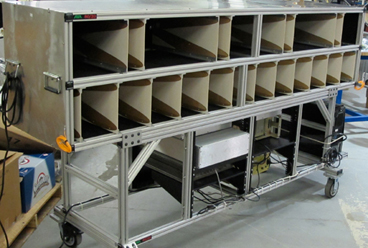Researchers Gregory Charvat and John Peabody at the Lincoln Laboratory in MIT have developed a new radar system that can see through walls. The new technology provides real-time video of activities occurring on the other side of a wall.
 The front of the phased array radar system developed by researchers at MIT’s Lincoln Laboratory, which sends and receives signals of movement behind solid concrete walls.
The front of the phased array radar system developed by researchers at MIT’s Lincoln Laboratory, which sends and receives signals of movement behind solid concrete walls.
Building a radar system that has the capability to penetrate walls and provide visuals of the activities behind walls has been a difficult task. The MIT researchers built a device with an array of antennas consisting of 13 transmitters and eight receiving elements, and computing equipment. It includes advanced algorithms and digital processing to provide good resolution and image processing. The device can be mounted on a mobile cart.
The researchers tested the system on 4” and 8” thick walls made of cinder-block and solid concrete. Initially, their radar functions similar to any other radar. Waves of a specific frequency are transmitted in the target direction. Over 99% of the radar waves that strike the wall each time are blocked by the concrete wall. It is essential that the waves, which bounce off any object is transmitted through the concrete wall to the radar receivers. Again 99% of the waves are blocked, which reduces the strength of the signal to around 0.0025%.
According to Charvat, it is appropriate to use a long radio wavelength and these waves can be transmitted through the wall and then return back easily contributing to a stronger signal. The researchers chose S-band waves for transmission, as it allowed restricting the length of the device to 8.5 ft. S-band waves are short waves which require amplifiers due to their higher signal loss.
Seeing through walls - MIT's Lincoln Laboratory
The radar device cannot detect inanimate objects. As it employs a subtraction method, it is capable of detecting only moving targets, including humans. The subtraction method involves comparing every new image to the previous and discovering what has changed. The digitized signals are converted into a video and presently humans are seen as “blobs” moving on the screen very similar to a bird’s-eye-view. The researchers are presently exploring algorithms that can automatically change the blob into an understandable symbol rendering the system more user friendly. The device can be used for military operations, including combat situations in urban areas.